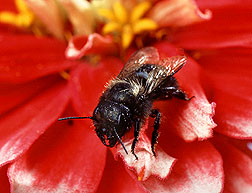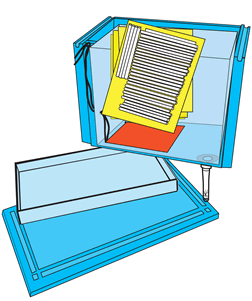This page has been archived and is being provided for reference purposes only. The page is no longer being updated, and therefore, links on the page may be invalid.
|
|
|
|
|
|
Newly Designed Bee-Box Boosts Pollinators' Readiness
By Marcia WoodJanuary 22, 2008
Hardworking blue orchard bees can be coaxed out of their snug winter cocoons just in time to pollinate the year's earliest and best blossoms, thanks to a newly designed box for these slumbering pollinators.
Bee experts with the Agricultural Research Service (ARS) Pollinating Insects Biology, Management and Systematics Research Unit in Logan, Utah, created the box to help growers and beekeepers ensure that blue orchard bees (Osmia lignaria) or other wild bees are ready to help America's harried honey bees (Apis mellifera) pollinate fruit or nut trees—or other crops—as soon as they begin to flower.
Synchronizing bees and blooms is tricky, according to ARS research entomologist Theresa L. Pitts-Singer at Logan. For example, almond trees may burst into bloom when still-wintering bees aren't yet ready to pollinate them.
Pitts-Singer, Logan technician Glen E. Trostle, and former Logan entomologists William P. Kemp, now with ARS in North Dakota, and Jordi Bosch, now in Spain, designed and tested the housing unit, called a "bee warming and emergence box." ARS is seeking a patent.
Tests in a California almond orchard and Utah apple orchard—with about 450 female blue orchard bees in each—showed that approximately 50 percent of the bees sheltered in the new boxes flew outdoors by the fourth day of the test. That was two days earlier in California and seven days earlier in Utah than bees emerging from traditional, unheated wood blocks.
For the experiment, prototype units—made of polycarbonate and polystyrene foam, and measuring 16 by 10 by 13 inches—were slipped inside wood shelters in the orchards. Each prototype included a heating unit, thermostat and clear tube for bees to use as an exit. Some daylight comes into the box through the clear tube, so that bees can find their way out.
Flexible bristles lining the tube allow bees out, but not back in. That's a plus, because it encourages the bees to make new, clean nests in wood blocks nearby.
ARS is the U.S. Department of Agriculture's chief scientific research agency.


